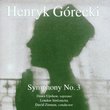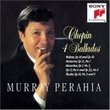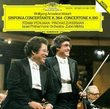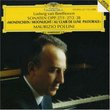| All Artists: Franz [Vienna] Schubert, Murray Perahia Title: Schubert: Piano Sonatas, D958, 959, 960 Members Wishing: 0 Total Copies: 0 Label: Sony Release Date: 5/13/2003 Genre: Classical Styles: Chamber Music, Forms & Genres, Sonatas, Historical Periods, Classical (c.1770-1830), Romantic (c.1820-1910) Number of Discs: 2 SwapaCD Credits: 2 UPC: 696998770621 |
Search - Franz [Vienna] Schubert, Murray Perahia :: Schubert: Piano Sonatas, D958, 959, 960
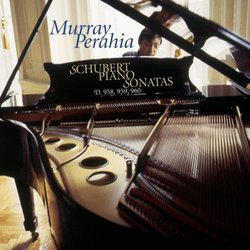 | Franz [Vienna] Schubert, Murray Perahia Schubert: Piano Sonatas, D958, 959, 960 Genre: Classical
Perahia's up against some heavy competition from the likes of Arrau, Brendel, Pollini, as well as old-timers like Schnabel and Edwin Fischer. Even in such company he acquits himself well, playing with lean sonority that cl... more » |
Larger Image |
CD DetailsSynopsis
Amazon.com Perahia's up against some heavy competition from the likes of Arrau, Brendel, Pollini, as well as old-timers like Schnabel and Edwin Fischer. Even in such company he acquits himself well, playing with lean sonority that clearly etches Schubert's melodic lines and clarifies the structure of these sprawling works. In the B-flat Sonata he clearly differentiates the basic tempos of the first two movements, which can often blend into each other by pianists who just play them as two slow movements. In the great Andantino movement of the A major, he's alive to its inherent weirdness as Schubert sends a nostalgically beautiful melody off the deep end to fragmentation, then reassembles it into a broken shadow of itself. His approach here is effective, if relatively restrained as he keeps to a generally classical view of works some turn into Romantic extravaganzas. Perahia's is a worthy addition to the Schubert discography and an excellent way to get fine performances of all three of these great works in one well-recorded, neatly space-saving package. --Dan Davis Similar CDs
Similarly Requested CDs |
CD ReviewsMature, thoughtful, beautifully-wrought late Schubert J Scott Morrison | Middlebury VT, USA | 11/17/2003 (5 out of 5 stars) "This is the second time that Perahia has recorded the middle of these three late sonatas, the well-loved Sonata in A, D. 959. I bought the 2 CD set primarily to hear what he might have to say some 13 years after the original recording. And I was concerned about his technical assurance after several years of physical problems with his hands. I needn't have worried on that account. If anything this reading is more olympian, more assured, more elegant. Earlier reviewers here have asked for more fire. Not I. I want these sonatas to sound like they were handed down from God--as they may have been, who knows?--and in that Perahia succeeds. Just listen to the final movement, the Rondo, of the A major sonata--the one made familiar to millions in an orchestrated version that was the themesong of the popular US sitcom, 'Wings.' I have never heard such songful playing from anyone--this includes Brendel, Goode, Uchida--which is certainly apt for Schubert, our most inspired writer of song melodies. When I got to that fourth movement I hit the repeat button and played it four times in a row, I was so enthralled. Coupled with that is the elfin leggiero of the movement preceding it--almost Mendelssohnian. This is spectacular playing AND spectacular thinking about this great music. The less-familiar C minor sonata, D. 958--and it is less familiar because it is just a hairbreadth less heavenly than its successors--has a convincing case made for it by Perahia. He does this by emphasizing the ceremonial aspects of the piece--'This is Important Stuff'--by de-emphasizing the corny Alberti-bass recurrences of the accompaniment, using a consistently full but rounded tone, and drawing our attention to the rock-solid formal construction. Hewn from granite, this music. Many people's favorite Schubert sonata is the final Sonata in B flat major, D. 960. They need not fear that Perahia will distort or underplay its grandeurs. There is a temptation in this sonata to overemphasize the mystery presaged by that ominous low-bass G-flat trill in the opening measures. My own take on that trill, and those that follow it, is that they are primarily harmonic devices, preparing us for the way Schubert takes us far afield. Yes, they are mysterious but they become less and less so, even dying out without a whimper eventually. Perhaps this is a triumph of light over dark? Who knows what Schubert had in mind. As Perahia plays--in unfailingly beautiful tone, be it said--one is not made uneasy by all this, rather one is exalted--by the beauty of the themes, the odd rightness of the unusual harmonies, by the inevitability of the form; the latter is the kind of thing that makes you go 'Of COURSE!' when the form is finally laid out, but it is not easily predicted beforehand. The Andante sostenuto is, to my mind, the most Beethovenian of Schubert's slow movements, and it is given that kind of solemnity and substance by Perahia. The Scherzo that follows comes as an emotional relief from the seriousness of the Andante; Perahia is not often considered to be much of a jokester, but he makes this movement chuckle. The closing Rondo is played with a straight-face, but occasionally hears Perahia (and, of course, Schubert) smiling. And most of all, it dances. An unusually satisfying traversal. I have liked Brendel's recordings, also Uchida's and Goode's. But at least for now these by Perahia are my favorites. This 2 CD set has about 112 minutes of music--roughly the amount one would get these days on 1 1/2 CDs--and the price reflects that; that is, one pays about 1 1/2 times what one would pay for one full-price CD. One last word: the booklet notes by Charles Fisk are elegantly written and more informative than most.Recommended without reservations.Scott Morrison" Schubert for the thinking man chefdevergue | Spokane, WA United States | 12/15/2003 (5 out of 5 stars) "The late Schubert sonatas are to the pianist what the Bach Partitas & Sonatas are to the violinist --- works that cannot be approached casually, and which require a certain maturity on the part of the artist. With these recordings, Perahia demonstrates his continuing maturity as an artist in recent years.Perahia allows the music to unfold on its own accord, something which is crucial for Schubert's late instrumental works. His tempi & dynamics are careful & measured, for he knows exactly what each sonata individually requires. The sometimes extreme dynamics of D959, for example, would be wildly out of place in D960. The 1st movement of D958 requires a very steady pace & crescendi that are gradual but not hurried. It is far too easy to let the tempo & dynamics get the better of the artist, but Perahia clearly has control over this.Throughout all three sonatas, Perahia's tone is sustained and natural, of the most reflective & thoughtful nature. These performances certainly stand up favorably in comparison to the much-ballyhooed series of Uchida, as well as the classic Brendel recordings. This is a crucial recording for those who want to explore the full complexities & nuances of the late Schubert sonatas." Beautiful, Solid Schubert D. Beck | Boston, MA | 08/26/2004 (5 out of 5 stars) "Murray Perahia has established himself as one of today's most compellingly lyrical pianists. This recording of Schubert's last three piano sonatas is no exception. Perahia, while in possession of a beautiful basic tone, uses his mastery of color to accentuate Schubert's subtle and often somber changes of mood and expression. This in fact is probably Perahia's strong point--that he follows exactly what is written in the score while making a poignant statement rather than blindly following the composer's instructions. He executes extremely well. This also may be a drawback to this set, that it lacks a certain spontaneity. However, this is not extremely dramatic, spontaneous music, and Perahia's style fits it well. He handles the bigger moments in the sonatas well, such as the second movement of the A Major Sonata. He will never be the pianist to go to for the Liszt b minor sonata, but that is fine because Perahia is playing Schubert as opposed to Liszt."
|

 Track Listings (8) - Disc #1
Track Listings (8) - Disc #1


